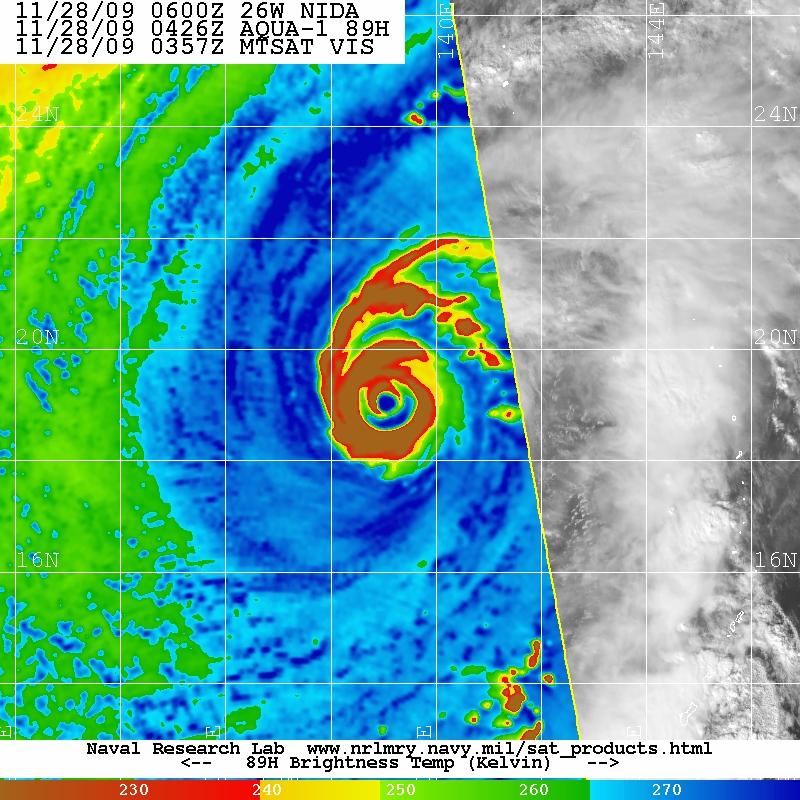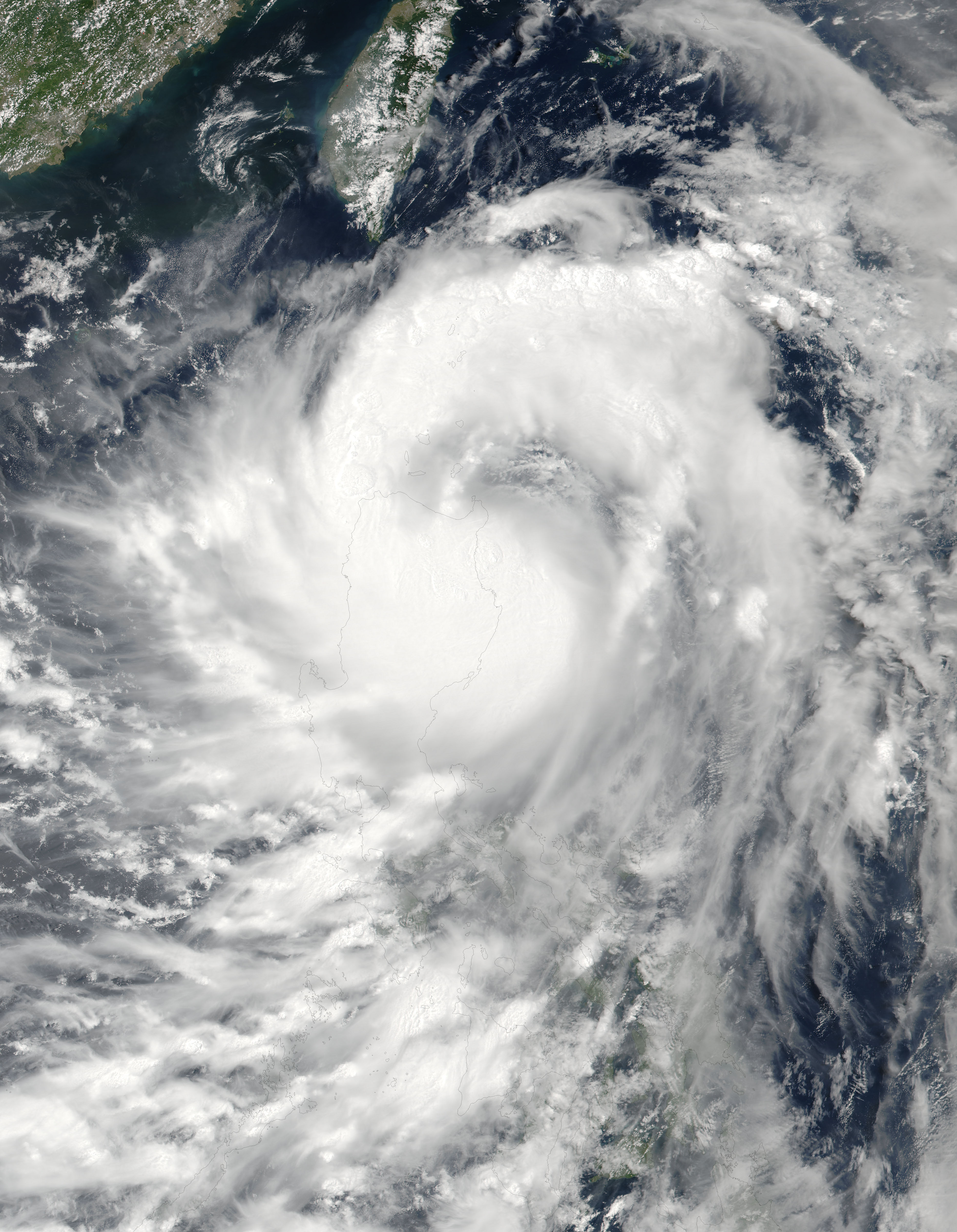|
Typhoon Nida (other)
The name Nida ( th, นิดา, ) has been used for three tropical cyclones in the western north Pacific Ocean. The name was contributed by Thailand and means a name of woman. *Typhoon Nida (2004) (T0402, 04W Dindo) – Category 5 super typhoon that formed southeast of the Philippines in mid-May that reached peak strength not far from the east-central Philippines and finally became extratropical east of Japan. *Typhoon Nida (2009) (T0922, 26W, Vinta) – Powerful Category 5 super typhoon that formed within a monsoon trough 545 miles (880 km) southeast of Guam in late November and reached 10-minute peak winds of 130 mph (215 km/h) *Tropical Storm Nida (2016), Severe Tropical Storm Nida (2016) (T1604, 06W, Carina) – Impacted the Philippines and South China as a severe tropical storm. *Tropical Storm Nida (2021), Severe Tropical Storm Nida (2021) (T2111, 15W) - didn't affect land. {{DEFAULTSORT:Nida Pacific typhoon set index articles ... [...More Info...] [...Related Items...] OR: [Wikipedia] [Google] [Baidu] |
Tropical Cyclone
A tropical cyclone is a rapidly rotating storm system characterized by a low-pressure center, a closed low-level atmospheric circulation, strong winds, and a spiral arrangement of thunderstorms that produce heavy rain and squalls. Depending on its location and strength, a tropical cyclone is referred to by different names, including hurricane (), typhoon (), tropical storm, cyclonic storm, tropical depression, or simply cyclone. A hurricane is a strong tropical cyclone that occurs in the Atlantic Ocean or northeastern Pacific Ocean, and a typhoon occurs in the northwestern Pacific Ocean. In the Indian Ocean, South Pacific, or (rarely) South Atlantic, comparable storms are referred to simply as "tropical cyclones", and such storms in the Indian Ocean can also be called "severe cyclonic storms". "Tropical" refers to the geographical origin of these systems, which form almost exclusively over tropical seas. "Cyclone" refers to their winds moving in a circle, whirling round ... [...More Info...] [...Related Items...] OR: [Wikipedia] [Google] [Baidu] |
Thailand
Thailand ( ), historically known as Siam () and officially the Kingdom of Thailand, is a country in Southeast Asia, located at the centre of the Indochinese Peninsula, spanning , with a population of almost 70 million. The country is bordered to the north by Myanmar and Laos, to the east by Laos and Cambodia, to the south by the Gulf of Thailand and Malaysia, and to the west by the Andaman Sea and the extremity of Myanmar. Thailand also shares maritime borders with Vietnam to the southeast, and Indonesia and India to the southwest. Bangkok is the nation's capital and largest city. Tai peoples migrated from southwestern China to mainland Southeast Asia from the 11th century. Indianised kingdoms such as the Mon, Khmer Empire and Malay states ruled the region, competing with Thai states such as the Kingdoms of Ngoenyang, Sukhothai, Lan Na and Ayutthaya, which also rivalled each other. European contact began in 1511 with a Portuguese diplomatic mission to Ayutthaya, w ... [...More Info...] [...Related Items...] OR: [Wikipedia] [Google] [Baidu] |
Typhoon Nida (2004)
Typhoon Nida, known in the Philippines as Typhoon Dindo, was the fourth tropical cyclone and second named storm of the 2004 Pacific typhoon season. Nida was the second super typhoon of the 2004 season, reaching a peak intensity of . Forming southeast of the Philippines, the storm strengthened as it moved northwest. The typhoon brushed the eastern Philippines causing heavy rains across the island archipelago. Nida later accelerated northeast, missing Japan to the east while becoming an extratropical cyclone. A total of $1.3 million (2004 USD) in damage occurred, and Nida left 31 fatalities. Meteorological history On May 12, a persistent area of thunderstorms formed within a monsoon trough southwest of Palau. Satellite imagery revealed a weak low-level circulation. Initially, the Joint Typhoon Warning Center (JTWC) forecast the storm to not strengthen. The following day, forecasters saw that the storm was strengthening and upgraded the system to tropical depression status. For ... [...More Info...] [...Related Items...] OR: [Wikipedia] [Google] [Baidu] |
Typhoon Nida (2009)
Typhoon Nida, known in the Philippines as Typhoon Vinta, was the most intense tropical cyclone worldwide in 2009. It was also the most intense tropical cyclone in the Northwest Pacific Ocean during the 2000s, tied with Jangmi in 2008. Meteorological history Early on November 21 the Joint Typhoon Warning Center (JTWC) reported that an area of convection had persisted within a monsoon trough about 880 km, (545 mi) to the southeast of Guam island. At this time the system was moving around the subtropical ridge of pressure, with an anticyclone over the cyclone helping the convection to consolidate over a broad and elongated low level circulation center which was located in an area of minimal vertical wind shear. Later that morning a Tropical Cyclone Formation Alert was released as deep convection increased in organization with multiple bands of convection starting to wrap into the developing low level circulation center. The system was then declared as a tropical depress ... [...More Info...] [...Related Items...] OR: [Wikipedia] [Google] [Baidu] |
Tropical Storm Nida (2016)
Severe Tropical Storm Nida, known in the Philippines as Severe Tropical Storm Carina, was a tropical cyclone that struck Luzon, Philippines and Guangdong, China in late July and early August respectively. The fourth named storm of the annual typhoon season, Nida formed on July 28, 2016 as a tropical depression in the Philippine Sea. Tracking generally north-northwestward, it intensified into a severe tropical storm and skirted northern Luzon before turning to the west-northwest, entering the South China Sea and intensifying further. Nida made landfall over Dapeng Peninsula in Shenzhen late on August 1 and dissipated on August 3. Meteorological history During July 28, the Japan Meteorological Agency started to monitor a tropical depression that had developed about to the east-southeast of Manila in the Philippines. The system had a broad low level circulation center which was consolidating, with atmospheric convection developing to the north and south of the depression. The syst ... [...More Info...] [...Related Items...] OR: [Wikipedia] [Google] [Baidu] |
Philippines
The Philippines (; fil, Pilipinas, links=no), officially the Republic of the Philippines ( fil, Republika ng Pilipinas, links=no), * bik, Republika kan Filipinas * ceb, Republika sa Pilipinas * cbk, República de Filipinas * hil, Republika sang Filipinas * ibg, Republika nat Filipinas * ilo, Republika ti Filipinas * ivv, Republika nu Filipinas * pam, Republika ning Filipinas * krj, Republika kang Pilipinas * mdh, Republika nu Pilipinas * mrw, Republika a Pilipinas * pag, Republika na Filipinas * xsb, Republika nin Pilipinas * sgd, Republika nan Pilipinas * tgl, Republika ng Pilipinas * tsg, Republika sin Pilipinas * war, Republika han Pilipinas * yka, Republika si Pilipinas In the recognized optional languages of the Philippines: * es, República de las Filipinas * ar, جمهورية الفلبين, Jumhūriyyat al-Filibbīn is an archipelagic country in Southeast Asia. It is situated in the western Pacific Ocean and consists of around 7,641 islands t ... [...More Info...] [...Related Items...] OR: [Wikipedia] [Google] [Baidu] |
South China
South China () is a geographical and cultural region that covers the southernmost part of China. Its precise meaning varies with context. A notable feature of South China in comparison to the rest of China is that most of its citizens are not native speakers of Standard Chinese. Cantonese is the most common language in the region while the Guangxi region contains the largest concentration of China's ethnic minorities, each with their own language. Administrative divisions Cities with urban area over one million in population Provincial capitals in bold. Namesake * South China tiger (southern China) * ''South China Morning Post'' (Hong Kong, South China) * Huanan Seafood Wholesale Market (Wuhan, Central China) See also * Lingnan * List of regions of China ** Southern China *** South Central China South Central China, South-Central China or Central-South China ( zh, c = 中南, p = Zhōngnán, l = Central-South), is a region of the People's Republic of China def ... [...More Info...] [...Related Items...] OR: [Wikipedia] [Google] [Baidu] |
Tropical Storm Nida (2021)
The 2021 Pacific typhoon season was the second consecutive to have below-average tropical cyclone activity, with twenty-two named storms, and was the least active since 2011. Nine became typhoons, and five of those intensified into super typhoons. This low activity was caused by a strong La Niña that had persisted from the previous year. The season's first named storm, Dujuan, developed on February 16, while the last named storm, Rai, dissipated on December 21. The season's first typhoon, Surigae, reached typhoon status on April 16. It became the first super typhoon of the year on the next day, also becoming the strongest tropical cyclone in 2021. Surigae was also the most powerful tropical cyclone on record in the Northern Hemisphere for the month of April. Typhoons In-fa and Rai are responsible for more than half of the total damage this season, adding up to a combined total of $2.017 billion. The scope of this article is limited to the Pacific Ocean to the north of the ... [...More Info...] [...Related Items...] OR: [Wikipedia] [Google] [Baidu] |
Typhoon Mirinae (other)
The name Mirinae has been used for three tropical cyclones in the Western Pacific Ocean. The name was contributed by South Korea and means the Milky Way in the Jeju language. It replaced the name '' Sudal'' on the Japan Meteorological Agency The , abbreviated JMA, is an agency of the Ministry of Land, Infrastructure, Transport and Tourism. It is charged with gathering and providing results for the public in Japan that are obtained from data based on daily scientific observation an ... naming list. * Typhoon Mirinae (2009) (T0921, 23W, Santi) – made landfall on Luzon, Philippines, and later Southern Vietnam. * Severe Tropical Storm Mirinae (2016) (T1603, 05W) – made landfall on Hainan, China, and later on Northern Vietnam. * Severe Tropical Storm Mirinae (2021) (T2110, 14W, Gorio) – remained out to sea. {{DEFAULTSORT:Mirinae Pacific typhoon set index articles ... [...More Info...] [...Related Items...] OR: [Wikipedia] [Google] [Baidu] |
Tropical Storm Omais (other)
The name Omais has been used to name four tropical cyclones in the northwestern Pacific Ocean. The name was contributed by the United States of America, and is a Palauan word for "wandering around". * Tropical Storm Omais (2004) (T0403, 06W, Enteng) - a weak storm that formed in May of 2004. * Tropical Storm Omais (2010) (T1001, 02W, Agaton) - recurved out to sea as a tropical storm * Tropical Storm Omais (2016) (T1605, 07W) - recurved out to sea, later threatening Alaska as an extratropical cyclone * Tropical Storm Omais (2021) (T2112, 16W, Isang) - A long-lived tropical cyclone which affected South Korea and the Mariana Islands The Mariana Islands (; also the Marianas; in Chamorro: ''Manislan Mariånas'') are a crescent-shaped archipelago comprising the summits of fifteen longitudinally oriented, mostly dormant volcanic mountains in the northwestern Pacific Ocean, betw .... {{DEFAULTSORT:Omais Pacific typhoon set index articles ... [...More Info...] [...Related Items...] OR: [Wikipedia] [Google] [Baidu] |



